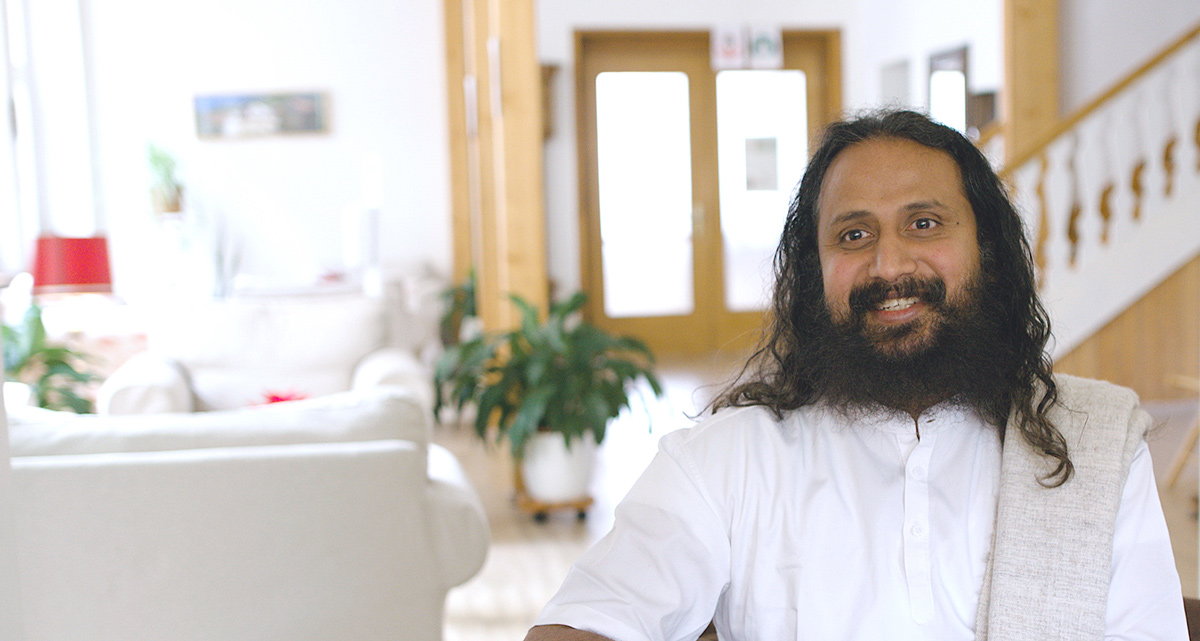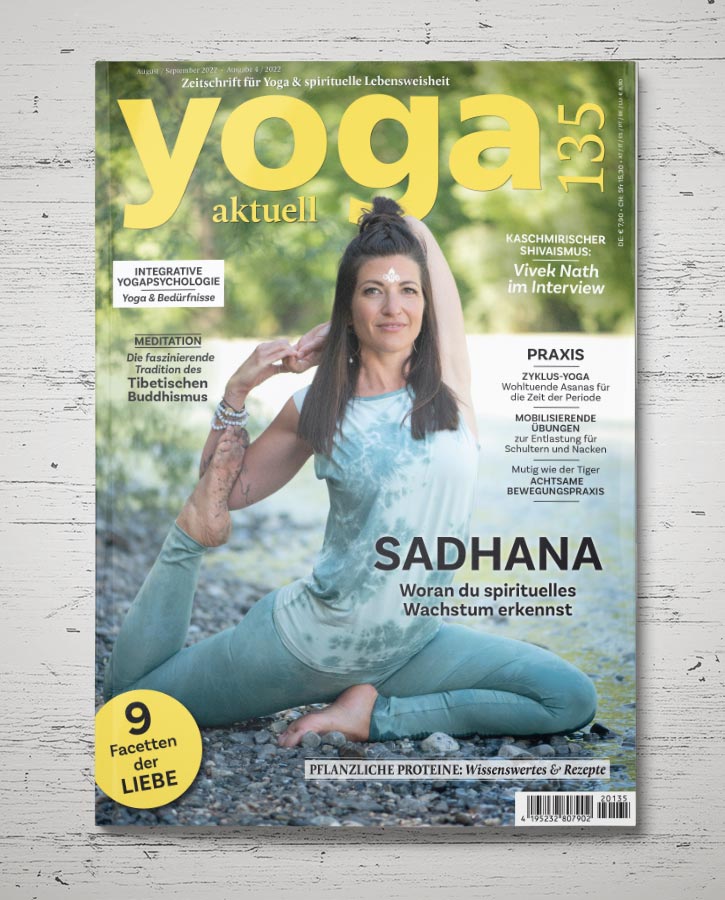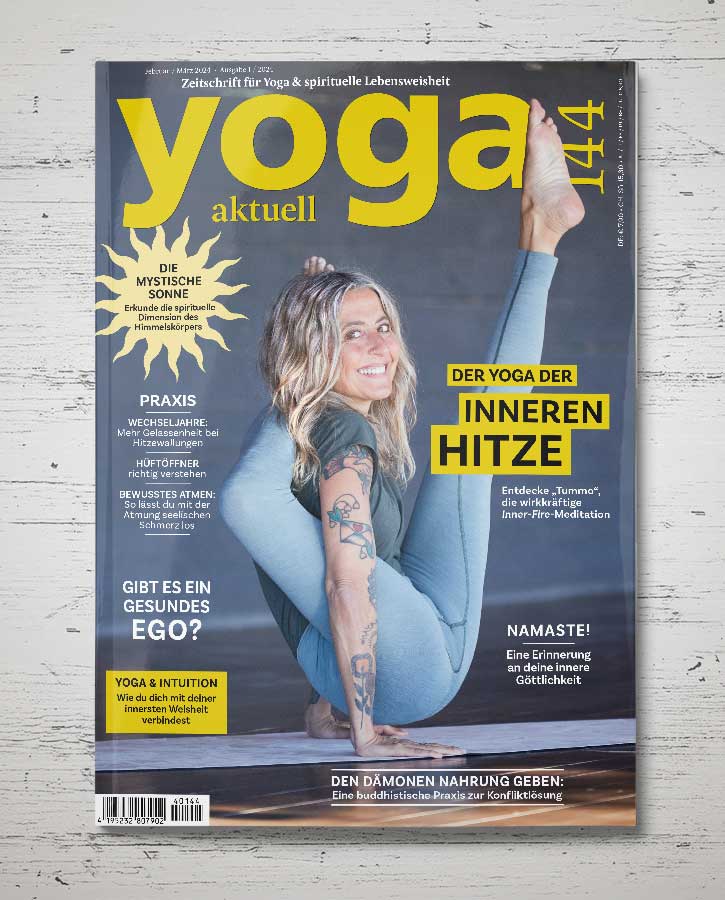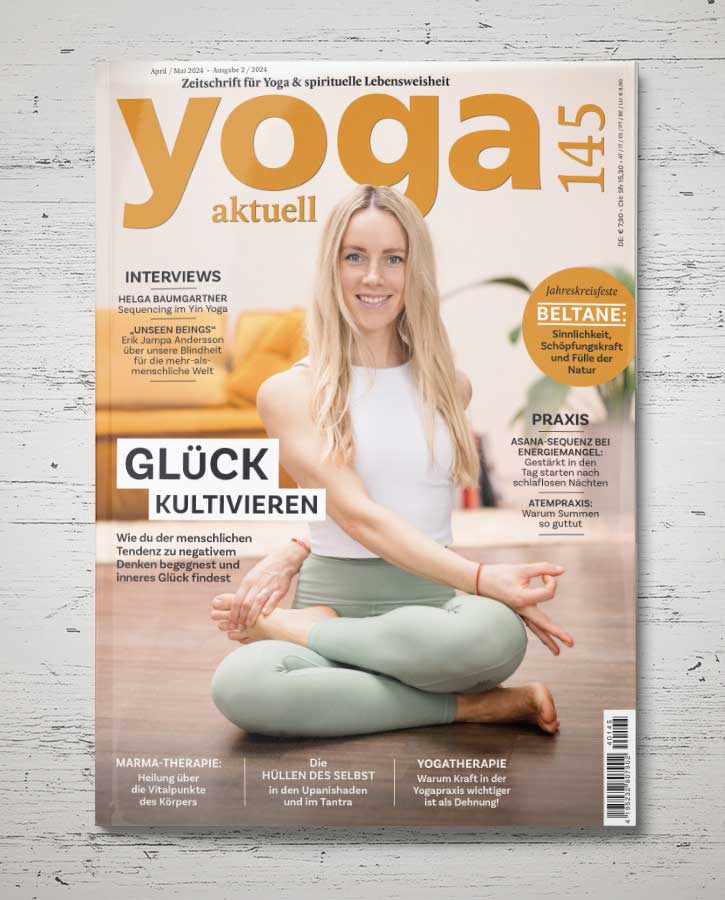As a representative of the Art of Living Foundation, Swami Jyothirmayah teaches breathing techniques and meditation to an audience all over the world. With YOGA AKTUELL he talked about the sources of vital energy, joy and creativity.
Swami Jyothirmayah teaches deep insights as well as methods helping to get in touch with your innermost sources in an impressively simple and clear manner. An immediate impression of what he teaches can also be felt in his very presence – the sereneness which he radiates, together with his receptiveness and compassionate alertness for life’s difficulties, gives evidence of what the breathing and meditation techniques he teaches to disciples all over the world are able to ignite.
Swami Jyothirmayah ist a Swami of the Art of Living Foundation, the renowned NGO founded in Bangalore in 1981 by Sri Sri Ravi Shankar. Due to the corona crisis he has been staying in Bad Antogast / Black Forrest for a couple of months now and is continuing his programmes from there for now. With YOGA AKTUELL he talked about the sources of life energy, about truly rejoicing in our existence and about what we can learn from children.
INTERVIEW
YOGA AKTUELL: How long have you been staying in the Black Forrest now and how has it changed the way you are reaching out to your students and spreading your teachings?
Swami Jyothirmayah: I came to Bad Antogast a couple of months ago. Before that I used to travel to more than 25 countries every year. For the last year the programmes have been happening online only, but that’s how the situation is. I try to make myself available as much as I can. But you have to consider the different time zones, so I start my day at 3.30 am and the sessions start at 4.30 CET. I am basically sharing what I’ve learned on this beautiful path during the last 23 years and I am also grateful to listen to what people tell me. Recently I keep hearing a lot of touching stories from people who have not given any attention to their mental well-being before the pandemic, but now are much more conscious of the fact that it is not only about physical fitness or about a superficial level. It seems that many people have now started looking for something more meaningful in their life.
That’s beautiful! On the other hand there might be people who are feeling so desperately weighed down by what is currently going on that they drop their former practice of yoga or meditation. What kind of encouragement could you give to them to help them start again?
This is not the end of the world. Humanity had so many challenges before. We have the ability to overcome these kind of situations. The world is facing a challenge, but if you constantly look at the challenges only, your energy level goes down. Life is a play of energy: If your prana is very high, then you have a solution to the challenges. If your energy is low, you feel depressed and you are facing self-doubts. It is alarming how many people are committing suicide – even children. For most people we can say that neither at home nor at school anybody told us how to handle our emotions. We learn many things, but we don’t learn how to win over our mind. If you can connect to inner peace – which is the very purpose of yoga – you will not only experience calmness, but you will live with more passion and there will be more dynamism and skill in your actions. Yoga also means broadening your vision of life.
As a practical advice to support your energy I would say: First take a look at your eating habits. Food is one of the four main sources of energy, so it is very important. It should be proper food – and not too much, but also not too little.
The second source of energy is good sleep without disturbance.
And the third source of energy is breathing. Our life begins with breath – the first thing we all do in life is to breathe in. At the end of our lives we breathe out for one last time; our life is happening between these two breaths. Without breath, there is no life. Without sleep you can survive a couple of days. It is very difficult, but possible. We can also survive a certain time without food. But how many days or hours or even minutes can we survive without breath? We have to give more attention to the breath. Breath is also the best friend of our mind and our emotions.
The fourth source of energy is meditation and peace of mind.
You mentioned that breath and emotions are intertwined. Could you explain this a little bit further?
Whenever our emotions change, our breath changes, too. When you are happy you breathe deeply. Whenever you are calm and peaceful, your breath becomes very steady and stable. But when you are disturbed, your breath is getting shallow. And when you get angry, you are starting to breathe very fast. So you can see how breath and emotions are connected. Now if you give attention to your breath, you can control your emotions. It is normal to get upset from time to time, it’s not a bad thing. It is just part of life. But if you cling to those negative emotions, life tends to slip into misery.
Most of our issues happen within our close relations, with our family or with our girl-friends or boy-friends. These issues do not occur because of lack of love, but rather because of lack of communication. Our intentions might be very good, but the way or the timing of communicating them might not be appropriate. And here yoga comes in again: Yoga gives you more skill in communication, in how you are using your words.
Let’s also talk get back to the fourth source of energy, meditation…
If there is silence in our mind, then the real life begins. Otherwise we just exist, but we are not really living. One source of happiness is abiding in yourself. That’s the source of all creativity, deep and powerful. The source of creativity is silence.
It seems that many people are not really aware of the fact that dealing with all those thoughts running through our minds means a lot of energy effort.
Our mind has a tendency to travel to the future and to the past while it will seldom come to the present moment. But if your thoughts are always directed into the future, you lose this precious moment and at the same time anxiety and fear come in. This will not help you. Some of us are caught in their past, still residing there. That usually means they are suffering in the present moment, because they feel regret about the past. Sometimes we also glorify our past. Even though the past is not there anymore, we are not ready to give it up.
So how to bring the mind to the present moment? The meditation practice has to go along with a certain wisdom and insight. You need to understand that everything on this planet is changing. Nothing is permanent here. You can see it everywhere. You can observe lots of changes happening in Mother Nature, and just like there are changes outside there are also changes inside of us. There are so many changes in our body. Cells are dying and new cells are created. Our thoughts and feelings are changing, too; they are not permanent. Yet something deep inside is not changing – that’s why you are able to observe these changes at all. There has to be a reference point.
I guess that’s the place where we should turn to in our quest for security, but we keep searching in all other places first. And even if we start looking for that profound inner silence, we easily get distracted. What can we do about it?
Enjoy your life, enjoy this world – but without any feverishness. The whole world is in front of us. The Black Forrest with its mesmerizing landscape for example is so beautiful. I could keep on looking at the scenery. But how long can I keep on? There is no limit to the scenery, but we have a limitation. Our senses are limited. You can enjoy two or three songs, ten songs, a concert. But then you will say it’s enough. We have those limitations as we are here on this planet for such a short time. It’s important to have that understanding that everything in your life is impermanent. Billions of people have lived here before us. They have all gone, and now we are here – but how many more years? Our life span is very, very short. If you are aware of the impermanence of this creation you are able to let go. The fear will disappear and you will be able to celebrate your life and to live it with joy and lots of compassion. And then the real life begins.
And then we can rediscover that beautiful lightheartedness which is always part of your workshops as I’ve heard. Don’t we all need more playfulness and more of a childlike attitude towards life?
The very purpose of yoga, meditation, reading and knowledge and of doing social service activities is to go back to that childlike innocence. All the children are yogis, because they are always in the present moment. Whatever they do, they do it hundred percent. They dance, they sing, they jump, they play, they study… Even when they cry, they cry a hundred percent. And they never keep emotions for long, they are able to let go. We, on the other hand, tend to dwell on it and keep it on our mind and this is affecting our health.
Often we are not capable of accepting people or situations just as they are. But this will not change the situation. If you keep thinking about your problems in a negative way you are just aggravating them, because what you design in your mind is also manifesting in front of you.
There is a beautiful secret about our life that includes intention – in Sanskrit we say Sankalpa –, attention and manifestation. If you keep a strong wish inside of you, just keeping it is not enough for your intention to manifest. You will have to work for it, to galvanize energy for that. If you plant a seed into the ground, you will also have to water it and to nurture it, then one day you’ll see the flowers grow.
And is it also about trust to some extent? I mean: You can sow the seed and water it, but yet you don’t really know if it is going to grow. You will also have to leave it to the Divine.
Trust is an important point. There are three different types of trust: Trust in others, trust in ourselves and trust in the unseen energy.
If you don’t have any trust in other people, you cannot fully trust yourself, either. And we should consider that people change. We cannot put labels on people saying: “That person is always like that.” We all go through some challenging times in our lives. So we have to understand other people much better and we have to trust them. If somebody is not behaving well towards us, sometimes that means we should show more compassion and love to them. Maybe they are facing a stressful period. If somebody is sick for example, what can you expect from them? You have to give them your compassion and your good wishes. So there is trust in the invisible, trust in other people and – as the third one – trust in yourself.
Just like the founder of the Art of Living Foundation, you have been asked to participate in negotiations in conflict areas where there were severe situations of crisis, with no trust on either side and no peaceful solutions in sight. Where did you start to find common ground where division seemed to be so prevailing?
Whenever we go to conflict areas, we go with an open mind – without any concepts, without any prejudice. We are ready to listen to both sides. We let them know very clearly that we do not want anything from them, we are just there for them.
The Art of Living Foundation has done fourty years of service around the world and our mission is a violence-free society. Non-violence is the great principle of Mahatma Gandhi. So many wars were fought throughout history and we did not get anything out of it. Violence cannot solve the disturbed mind and the violence.
Thank you so much for this interview!
|
The Art of Living Foundation dedicates itself to spreading yoga, meditation and breathing techniques (especially Sudarshan Kriya Yoga) by means of lessons offered in more than 150 countries all over the world and attends to humanitarian projects such as support in developing countries, trauma healing programmes, help for violent crime victims as well as social reintegration for prisoners. Furthermore, the AOL takes part in peace negotiations in political hot spots. For example, Sri Sri Ravi Shankar brought about the critical impulse for a peaceful agreement in negotiations with the FARC rebels in Colombia in 2015. www.artofliving.org |









